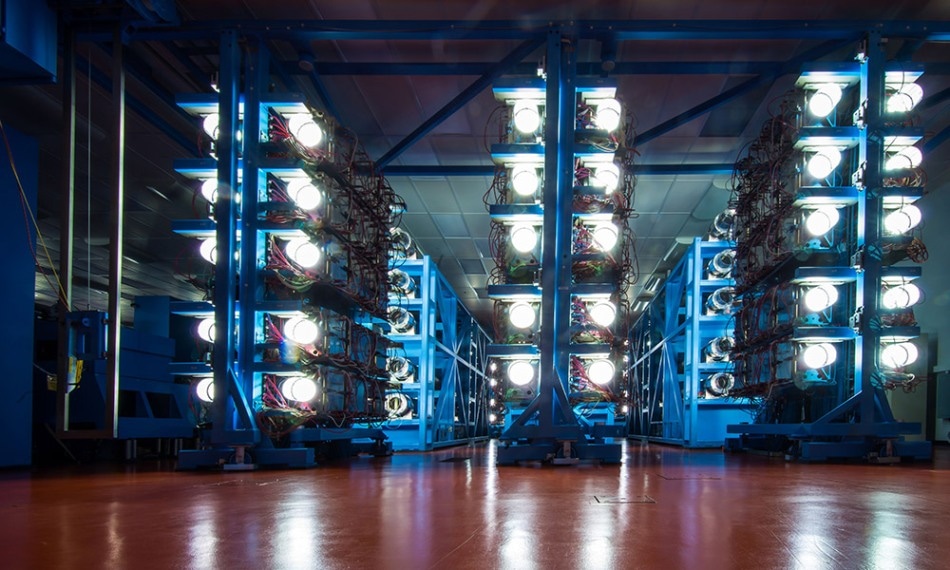Dec 3 2019
A new study by researchers at the University of Rochester will improve the accuracy of computer models employed in simulations of laser-induced implosions. The study has been reported in the Nature Physics journal and offers a solution to one of the challenges in the research community’s long-time pursuit to realize fusion.
 Researchers used the Omega Laser Facility at the Rochester’s Laboratory for Laser Energetics to make highly detailed measurements of laser-heated plasmas. Image Credit: University photo/J. Adam Fenster.
Researchers used the Omega Laser Facility at the Rochester’s Laboratory for Laser Energetics to make highly detailed measurements of laser-heated plasmas. Image Credit: University photo/J. Adam Fenster.
Laser-induced inertial confinement fusion (ICF) experiments, for example, the experiments performed at the University of Rochester’s Laboratory for Laser Energetics (LLE), involve the delivery of energy to heat by short beams made of intense pulses of light—pulses that last just one-billionths of a second—and compressing a target of hydrogen fuel cells. In principle, this process would liberate more energy than what is used to heat the system.
Laser-induced ICF experiments mandate several laser beams passing through a plasma—a hot soup of ions and electrons that move freely—and depositing their radiation energy accurately at the intended target. However, when the beams do so, they tend to interact with the plasma in ways that can complicate the targeted result.
ICF necessarily generates environments in which many laser beams overlap in a hot plasma surrounding the target, and it has been recognized for many years that the laser beams can interact and exchange energy.
David Turnbull, Study First Author and Scientist, Laboratory for Laser Energetics, University of Rochester
If researchers have to accurately model this interaction, they must know precisely how the laser beam’s energy interacts with the plasma. Although researchers have proposed theories on the ways in which laser beams modify a plasma, they have never been able to demonstrate this experimentally.
For the first time, scientists at the LLE, in collaboration with colleagues at Lawrence Livermore National Laboratory in California and the Centre National de la Recherche Scientifique in France, have now directly shown how laser beams alter the conditions of the underlying plasma, thereby having an impact on the energy transfer in fusion experiments.
The results are a great demonstration of the innovation at the Laboratory and the importance of building a solid understanding of laser-plasma instabilities for the national fusion program.
Michael Campbell, Director, Laboratory for Laser Energetics, University of Rochester
Using Supercomputers to Model Fusion
Usually, supercomputers are used by researchers to investigate the implosions that take place in fusion experiments. Thus, it is vital that these computer models precisely define the physical processes involved, such as the exchange of energy from the laser beams to the plasma, and ultimately to the target.
In the last 10 years, scientists have made use of computer models that describe the mutual laser beam interaction that occurs in laser-induced fusion experiments. But the models, in general, have assumed that the laser beams’ energy interacts in a kind of equilibrium called Maxwellian distribution—an equilibrium that would be expected in the exchange of energy when there are no lasers.
“But, of course, lasers are present,” stated Dustin Froula, a senior scientist at the LLE.
According to Froula, nearly four decades ago, scientists predicted that lasers modify the underlying plasma conditions in significant ways. A theory proposed in 1980 predicted these non-Maxwellian distribution functions in laser plasmas caused when the laser beams preferentially heat slow electrons.
Subsequently, Rochester graduate Bedros Afeyan ’89 (PhD) predicted that the impact of these non-Maxwellian electron distribution functions would vary depending on the way laser energy is transferred between beams. However, since there was a lack of experimental evidence to confirm that prediction, scientists did not take it into account in their simulations.
Turnbull, Froula, and physics and astronomy graduate student Avram Milder performed experiments at the Omega Laser Facility at the LLE to carry out highly comprehensive measurements of the laser-heated plasmas.
For the first time, the outcomes of these experiments reveal that the distribution of electron energies in a plasma is affected by its interaction with the laser radiation and can never be accurately characterized using existing models.
The new study not just verifies a long-time theory, but also demonstrates that laser-plasma interaction strongly modifies the energy transfer.
New inline models that better account for the underlying plasma conditions are currently under development, which should improve the predictive capability of integrated implosion simulations.
David Turnbull, Study First Author and Scientist, Laboratory for Laser Energetics, University of Rochester
This study is based on research supported by the U.S. Department of Energy’s National Nuclear Security Administration and the New York State Energy Research and Development Authority.